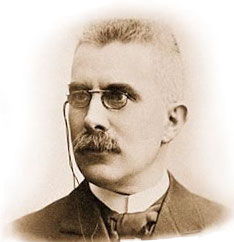
Henry Louis Le Chatelier
Henry Louis Le Chatelier (October 8, 1850 to September 17, 1936) Le Chatelier was a French chemist who discovered a fundamental principle that is obeyed by systems in equilibrium, which is now called “Le Chatelier’s Principle.” Though, as originally formulated by Le Chatelier, it concerned chemical equilibrium, the same principle has been found to apply much more generally, for example in physics and economics.
Henry Le Chatelier was the son of a famous engineer, Louis Le Chatelier, and, following in his footsteps, entered the École Polytechnique in 1869. At the age of twenty seven he was called to teach chemistry at the École des Mines in Paris. Ten years later, in 1887, he became Chair of the department of Industrial Chemistry there, a position he held until his retirement in 1919. From 1898 to 1907, he also was Chair of Mineral Chemistry at the Collège de France. Le Chatelier worked on a wide range of topics in chemistry, both basic and applied, doing important research, for example, in industrial chemistry, metallurgy, cements, and the combustion and explosion of mixtures of gases. What drew his interest to the last subject was a series of mine disasters in France. He developed devices for detecting small quantities of “marsh gas,” which contributed greatly to the safety of mines, as did his development of explosives that could more safely be used in them. His greatest fame, however, rests upon his discovery of Le Chatelier’s Principle. Linus Pauling, a Nobel Prize winner in chemistry, said the following on the importance of Le Chatelier’s Principle in his textbook on chemistry, in the chapter on chemical equilibrium:
“When you have obtained a grasp of Le Chatelier’s principle, you will be able to think about any problem of chemical equilibrium that arises, … . Some years after you have finished your college work, you may … have forgotten all the mathematical equations relating to chemical equilibrium. I hope, however, that you will not have forgotten Le Chatelier’s principle.”
The principle has been stated in many ways. Pauling stated it this way: “If the conditions of a system, initially at equilibrium, are changed, the equilibrium will shift in such a direction as to tend to restore the original conditions.” Another textbook stated it this way: “If a stress is applied to a system at equilibrium, then the system readjusts, if possible, to reduce the stress.” These statements illustrate that the principle applies not only to chemical equilibrium, but much more widely. Le Chatelier was the recipient of numerous honors in his lifetime, including honorary memberships in the scientific societies of many countries. In 1887, he was elected to the Légion d’honneur as a Chevalier, eventually being elevated to the rank of Grand officier in 1927.
Le Chatelier was known as an ardent Catholic. He was an honorary member of the Société scientifique de Bruxelles (Scientific Society of Brussels), an organization dedicated to Catholic engagement with modern science. Le Chatelier was also deeply devoted to his family. He and his wife, Geneviève, had seven children. The Revue de Metallurgie, a scientific journal which Le Chatelier founded in 1904, published a tribute to him after his death, which noted that
“On June 1,[1936], Pentecost Monday, Mr. and Mrs. Henry Le Chatelier, surrounded by their children, grandchildren and many relatives and friends, celebrated their diamond wedding at [the church of] Notre-Dame-des-Champs.”
The same tribute described his death, which occurred only a few months later, in this way:
“[H]e saw his last hour arrive in the calm of the great believers.”
Explore Other Scientists
It is our hope that this curated set of biographies will be useful to teachers, students, and the general public.